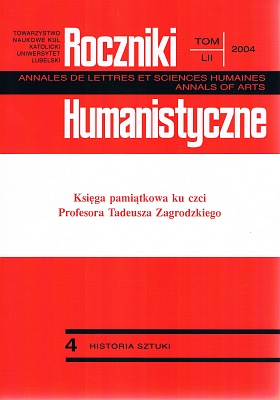Zwiastowanie z Mądrego jako przykład ikonografii Wcielenia
Abstrakt
The Annunciation from Mądre is an example of iconography of the Incarnation that appeared as eartly as the beginnings of Christian art, and through the ages it was a compilation of many various pictorial motifs. The painting of the Annunciation, kept in Kórnik, dated for 1529, was once the middle part of the altar in the parish church in Mądre. The figure of the founder, Łukasz Górka, shown at Gabriel's feet, confirms the authority of the humanist who ordered the work. The iconography of the painting connects the traditions of the medieval imaging of the Annunciation to Renaissance elements. At the background of the main scene, against the landscape, another event in Mary's cycle takes place – the Visitation to St. Elizabeth. A. Labuda points to the importance of this picture in the development of proto-Renaissance painting in Wielkopolska (Great Poland), with the complex motif of the Incarnation that introduces into the picture the Infant looking in the direction of Mary. A. Labuda has pointed to L. Górka's foundation as the Church's orthodox authority towards Lutheran ideas that had a powerful influence in the Wielkopolska region.
The Annunciation is characterized by a clear and cogent iconographic program built around the mystery of the Incarnation as the crucial moment of the Salvation. In the corner of the painting God the Father, the Infant as the Son-Logos carrying the cross on his shoulders, and the dove of the Holy Spirit have been shown. This moment of the Annunciation, joined to the image of the Father, was shown in the icon of Nowogród painted in the 12th century. God was shown as the Everlasting, according to the description in the Book of Daniel 7, 9 from Isaiah's prophecy 6, which also found its pictorial interpretations in Jacop Torriti's mosaics from Santa Maria Maggiore of 1247.
In the development of the presentations of Annunciation we are interested in, showing Logos descending from heaven, the art developed in the area on the Rhine was significant, since it was there that the trend of mysticism of the whole of the 15th century emphasizing divinity of Christ was consolidated.
The influence of the Renaissance way of thinking can be seen in the painting owing to the sibyls, already defined by Heraclitus, Euripides, Aristophanes, Plato and many other authors whose writings were used as sources by Christian writers. Especially three sibyls were considered to be authoritative oracles: the Phrygian one from Delphi, the Eritrean one and the Hellespont one. A special significance was attributed to the sibyls' prophecies in Rome. According to the legend related by Dionysius of Halicarnassus, Tarquinius the Proud bought books with prophecies from a mysterious woman identified with Sibyl of Cumae, and from the times of Augustus the books were kept in the Jove Temple in the Capitol. Ancient prophecies were joined to the texts of Jewish prophecies, forming in this way collections of sibyls' prophecies contained in twelve books. Christian oracles speak about the coming of Messiah, and some quotations were used by the Fathers of the Church. Clement of Alexandria in his work Stromata mentions four sibyls, Phrygian, Eritrean, Egyptian and Italian, called Carmentis. Initially in Christian art only one sibyl was shown, but in the late Middle Ages and in the Renaissance period more were introduced, together with the attributes that identified them. In early Renaissance art sibyls were often shown in the context of Evangelical events, e.g. on the stalls of the Ulm Cathedral whose author was Jorg Syrlin (1467-1474).
Copyright (c) 2004 Roczniki Humanistyczne

Utwór dostępny jest na licencji Creative Commons Uznanie autorstwa – Użycie niekomercyjne – Bez utworów zależnych 4.0 Międzynarodowe.





